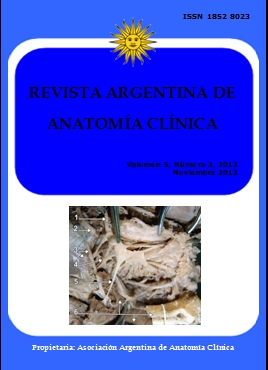DIAPHYSEAL NUTRIENT FORAMINA OF ADULT HUMAN TIBIA - ITS POSITIONAL ANATOMY AND CLINICAL IMPLICATIONS. Foramen nutricio diafisario de la tibia humana adulta – Su anatomía posicional y las implicancias clínicas
DOI:
https://doi.org/10.31051/1852.8023.v5.n3.14079Palabras clave:
Nutrient foramen, Clinical implications, Tibia., foramen nutricio, tibia, implicancias clínicas.Resumen
El conocimiento del número y posición de los forámenes nutricios en los huesos largos es importante en los procedimientos ortopédicos, tales como la terapia de reemplazo de articulaciones, reparación de fracturas, injertos de hueso y micro-cirugía de hueso vascularizado. El presente estudio se llevó a cabo en el departamento de Anatomía, Colegio Médico Gubernamental de Amritsar. El estudio comprendió 100 tibias de humanos adultos obtenidas de 50 cadáveres masculinos y 50 femeninos. Todos los huesos del presente estudio presentaban el foramen nutricio situado en el tercio superior del eje y se dirigían hacia abajo. En la mayoría de los huesos, se encuentró lateral a la línea vertical en la superficie posterior de la diáfisis tibial. Las distancias medias de foramen nutricio de los extremos superior e inferior de la tibia eran mayores en los hombres en ambos lados. Además, estas mediciones mostraron valores más altos en los huesos de la mitad derecha. El conocimiento preciso de la ubicación de la forámenes nutricios en los huesos largos es útil en la prevención de las lesiones intra-operatorias en cirugía ortopédica, así como en cirugía plástica y reconstructiva y también es relevante en la práctica médico-legal.
An understanding of the number and position of nutrient foramina in long bones is important in orthopedic procedures such as joint replacement therapy, fracture repair, bone grafts and vascularized bone microsurgery. The present study was conducted in the department of Anatomy, Govt. Medical College Amritsar. The study group comprised of 100 adult human tibiae obtained from 50 male and 50 female cadavers. All the bones of the present study depicted single nutrient foramen situated in the upper one third of the shaft and were directed downwards. In majority of the bones, it was located lateral to the vertical line on the posterior surface of tibial shaft. The mean distances of nutrient foramen from the upper and lower ends of tibia were found to be greater in males on both the sides. Also, these measurements showed higher values in the right sided bones.Precise knowledge of the location of the nutrient foramina in long bones is helpful in preventing intra-operative injuries in orthopedic as well as in plastic and reconstructive surgery and is also relevant in medicolegal practice.
Referencias
Bridgeman G, Brookes M. 1996. Blood supply to the human femoral diaphysis in youth and senescence. J Anat 188: 611 - 621.
Chhatrapati DN, Misra BD. 1967. Position of the nutrient foramen on the shafts of human long bones. J Anat Soc Ind 16: 54-63.
Collipal E, Vargas R, Parra X, Silva H and Sol MD. 2007. Diaphyseal nutrient foramina in the femur, tibia and fibula bones. Int J Morphol 25(2): 305-308.
Forriol Campos F, Gomez Pellico L, Gianonatti Alias M, Fernandez-Valencia R. 1987.A study of the nutrient foramina in human long bones. Surg Radiol Anat 9: 251 - 255.
Gumusburun E, Yucel F, Ozkan Y, Akgun Z. 1994. A study of the nutrient foramina of lower limb long bones. Surg Radiol Anat 16: 409-412.
Hughes H. 1952. The factors determining the direction of the canal for the nutrient artery in the long bones of mammals and birds. Acta Anat 15: 261-280.
Kate BR. 1971. Nutrient foramina in human long bones. J Anat Soc Ind 20(3): 139-145.
Kirschner MH, Menck J, Hennerbichler A, Gaber O, Hofmann GO. 1998. Importance of arterial blood supply to the femur and tibia for transplantation of vascularized femoral diaphyses and knee joints. World J Surg 22: 845 - 852.
Kizilkanat E, Boyan N, Ozsahin ET, Soames R, Oguz O. 2007. Location, number and clinical significance of nutrient foramina in human long bones. Ann Anat 189: 87-95.
Laing PG. 1953. The blood supply of the femoral shaft: An anatomical study. J Bone Joint Surg B 35: 462-466.
Lewis OJ.1956.The blood supply of developing long bones with special reference to the metaphyses. J Bone Joint Surg 38B: 928-933.
Longia GS, Ajmani ML, Saxena SK and Thomas RJ.1980. Study of diaphyseal nutrient foramina in human long bones. Acta Anat 107: 399-406.
Mysorekar VR. 1967. Diaphyseal nutrient foramina in human long bones. J Anat 101(4): 813-822.
Nagel A. 1993.The clinical significance of the nutrient artery. Orthop Rev 22:557-561.
Patake SM, Mysorekar VR. 1977. Diaphyseal nutrient foramina in human metacarpals and metatarsals. J Anat 124:299-304.
Sendemir E, Cimen A. 1991. Nutrient foramina in the shafts of lower limb long bones: situation and number. Surg Radiol Anat 13: 105 - 108.
Shulman SS.1959. Observations on the nutrient foramina of the human radius and ulna. Anat Rec 134: 685-697.
Skawina A, Wyczolkowski M. 1987. Nutrient foramina of humerus, radius and ulna in Human Fetuses. Folia Morphol 46: 17 - 24.
Trueta J. 1974. Blood supply and the rate of healing of tibial fractures. Clin Orthop Rel Res 105: 11 - 26.
Descargas
Publicado
Número
Sección
Licencia
Los autores/as conservarán sus derechos de autor y garantizarán a la revista el derecho de primera publicación de su obra, el cuál estará simultáneamente sujeto a la Licencia de reconocimiento de Creative Commons que permite a terceros compartir la obra siempre que se indique su autor y su primera publicación en esta revista. Su utilización estará restringida a fines no comerciales.
Una vez aceptado el manuscrito para publicación, los autores deberán firmar la cesión de los derechos de impresión a la Asociación Argentina de Anatomía Clínica, a fin de poder editar, publicar y dar la mayor difusión al texto de la contribución.



